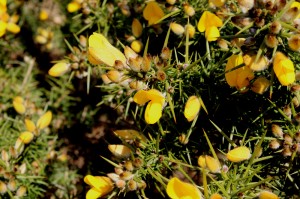 Amidst the cold, frost and snow of the last few weeks or so it was always tempting to look out for the first signs of spring. Despite the weather they were certainly there with butterbur on the banks of Loch Ness near Dores and primroses in blossom on the south facing slopes of the A 82 north of Fort Augustus. Some waders such as curlew and oystercatchers had started to move back back into the straths and glens and there was a general feeling of optimism despite the cold weather that persisted. However, if you looked hard enough there was one shrub that could be found in full flower all the way through the winter and one that is often just accepted or largely overlooked. The shrub is whin, sometimes known outside the north as gorse or furze. Whin can dominate the landscape to the exclusion of many other plants but it is a refuge for all manner of wildlife throughout the year. There is an old saying that “When the gorse is out of bloom, kissing is out of fashion”. Romantics may have no fears as the blossoms can be found, somewhere, all the year round.
Amidst the cold, frost and snow of the last few weeks or so it was always tempting to look out for the first signs of spring. Despite the weather they were certainly there with butterbur on the banks of Loch Ness near Dores and primroses in blossom on the south facing slopes of the A 82 north of Fort Augustus. Some waders such as curlew and oystercatchers had started to move back back into the straths and glens and there was a general feeling of optimism despite the cold weather that persisted. However, if you looked hard enough there was one shrub that could be found in full flower all the way through the winter and one that is often just accepted or largely overlooked. The shrub is whin, sometimes known outside the north as gorse or furze. Whin can dominate the landscape to the exclusion of many other plants but it is a refuge for all manner of wildlife throughout the year. There is an old saying that “When the gorse is out of bloom, kissing is out of fashion”. Romantics may have no fears as the blossoms can be found, somewhere, all the year round.
Despite its appearance is still susceptible to the cold as whilst you often have to search at inland sites to find the blossoms along the coast it is commonly in flower. A good example was the photograph that I took in mid March at Alterlie Point to the east of Inverness. The temperatures in and around Inverness are slightly warmer than those away from the coast. So at Alterlie Point there were several bushes that were well out and there was just that hint of the fragrance of almond from the rich yellow blossoms. There are some very extensive areas dominated by whins and one of the most spectacular, especially in the spring and summer, is parts of Drummossie Moor. The main area flanks either side of the minor road between Inverness Academy and Farr. When the blossoms are fully out there is an almost overwhelming fragrance from them that even filters into vehicles passing along the road.
As with other large areas of whins, it provides shelter, food and breeding sites for a few specialised birds that includes the stonechat. These are small birds belonging to the same family as whinchats but, unlike the latter, stonechats stay here all the year round. There are reputed to be around 20,000 pairs in Scotland and they are more than holding their own with the recent series of relatively milder winters. If the winter is severe their numbers “crash” but will recover again as they can raise two broods in one year. Amongst the wide range of wildlife that whins support there is, unexpected, a butterfly whose caterpillars feed on whin which may seem rather unpalatable to us. It is the green hairstreak that, as the name suggests, has green undersides and as you get a closer look they are very attractive. The books describe the green as “emerald green” which is apt. I make a point of searching for them every year but the dark upper sides can make them very difficult to see and they are easily overlooked. Whins have had a very long history of use by ourselves, varying from fodder for stock, when crushed in special machines, to the making of whin blossom wine. They were even planted near croft houses to put the washing on them to dry as the thorns kept the clothes from blowing away. One of the most versatile and important shrubs in the countryside.
